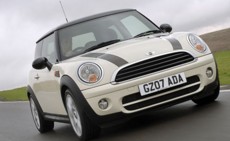Review

Incredible as it may seem, I had never driven a new MINI.
I have friends who fervently believe the original Issigonis design is the only true Mini, and I felt I’d be betraying them if I succumbed to the bubbly charms of the BMW-designed re-interpretation.
Well, that was part of the reason. The other was the previous new MINI model never had a sporty diesel model – instead relying on entry-level badging.
Until now. The introduction of the new, new Cooper D throws up potential concerns.
The MINI Cooper name is one of the most prestigious in motoring, conjuring up images of sporting prowess, performance and handling. Can a diesel engine really keep the essence of the Cooper moniker?
The diesel engine in question is a 1.6-litre unit producing 110bhp and 177lb-ft of torque, with an extra 15lb-ft available as an overboost function for quicker overtaking.
This powers the Cooper D to 62mph in 9.9 seconds and on to a top speed of 121mph.
Such figures might not sound scintillating, but once in the car and driving around it feels much more dramatic.
The driver sits so low that the road really does feel right underneath you. The low-down torque – available from just 2,000rpm – whips you along and it doesn’t even sound like a diesel.
Handling, as one would expect, is fantastic. No corner is too much of a problem – it just holds on and displays monumental grip.
It may be a bold statement, but I’d rate the Cooper D as one of the most fun diesel cars I’ve ever driven. So, driving enthusiasts can rest easy – the magic of Cooper remains.
It’s good news for the fleet manager, too. The new engine emits 118g/km of CO2, putting the car into band B for Vehicle Excise Duty. Combined mpg is a claimed 64.2, and although I didn’t get near that, I did average well above 50mpg.
It drives well, it’s economical – could this be the perfect car? Well, I do have a few niggles. The central speedometer is ridiculously oversized and I would much prefer it in front of me.
While the firm ride is great for bumbling along B-roads, those who prefer their cars to waft could find it a tad firm. There isn’t much room in the boot either.
My major gripe, however, is the amount of standard equipment, or lack of it.
The basic price of the car we tested was £14,175, but by the time we’d added rudimentary options such as air conditioning, height adjustment for the passenger seat, floor mats and a leather steering wheel, the price was up to £16,530. If you want more than the absolute basics, you’ll have to pay for them.
But nevertheless the Cooper D is a great little car and, with CAP estimating it will retain 51% of its cost new after three years and 60,000 miles it will appeal to both the head and the heart.
Fact file
P11D value: £14,105
CO2 emissions (g/km): 118
BIK % of P11D in 2007: 18%
Graduated VED rate: £35
Insurance group: 8
Combined mpg: 64.2
CAP RV (3yr/60k): £7,150/51%
Monthly lease (3yr/60k): £185
THREE RIVALS TO CONSIDER
P11D price
There’s an early setback for the MINI – with a desirable brand comes a sizeable pricetag and not much else. All the rivals are cheaper and better- equipped. The Ford offers the best value, although it is 20bhp down on the 110bhp Mini and 207. The Corsa offers 125bhp.
Fiesta: £12,407
207: £12,850
Corsa: £12,975
Mini £14,105
EMISSIONS AND TAX RATES
All the cars fall into the same BIK tax band, with the Fiesta coming top for those wanting the most environmentally-friendly vehicle.
The MINI is the most expensive for a 22% taxpayer, costing £46 a month. The Fiesta will cost £40 a month and the Corsa and 207 £42.
Fiesta: 116g/km/18%
MINI: 118g/km/18%
207: 126g/km/18%
Corsa 130g/km/18%
SMR COST
Finally the MINI starts to play its hand, being the cheapest thanks to its tlc pack which covers all servicing for five years/50,000 miles for £150.
The Ford and Vauxhall are evenly matched, while the Peugeot lags behind, costing nearly £350 more than the third-placed Corsa.
< Mini: 2.77 (pence per mile) £1,662 (60,000 miles total)
Fiesta: 3.05 £1,830
Corsa: 3.06 £1,836
207: 3.63 £2,178
Fuel cost
With claimed average fuel economy of 64.2mpg, both the MINI and Fiesta top the frugality list.
The Peugeot and Vauxhall cost around £350 more over a typical 60,000-mile fleet life. The 207 will return 58.8mpg while the Corsa is expected to achieve 58.9mpg.
Mini: 6.84 (pence per mile) £4,104 (60,000 mile total)
Fiesta: 6.84 £4,104
Corsa: 7.46 £4,476
207: 7.47 £4,482
Depreciation cost
The MINI romps ahead and even its high front-end price doesn’t count against it thanks to a strong residual value prediction from CAP of 51% after three years/60,000 miles. It’s close between the 207 and Fiesta on 32% and 30% respectively. The Vauxhall retains 28%.
Mini: 11.59 (pence per mile) £6,954
207: 14.41 £8,646
Fiesta: 14.47 £8,682
Corsa: 15.50 £9,300
Wholelife cost
Despite being more expensive to buy, the MINI’s excellent RV means the investment is recouped over the life of the vehicle. It will cost almost £2,000 less than the next-cheapest car, the Ford. The Peugeot and Vauxhall are off the pace, thanks to high fuel and SMR costs.
Mini: 21.20 (pence per mile) £12,720
Fiesta: 24.36 £14,616
207: 25.51 £15,306
Corsa: 26.02 £15,612
Verdict

You might need to pay extra for a few essential options, but the MINI is the car to go for here.
A well-recognised brand name sits on an excellent car – stylish, economical, good to drive and with an excellent resale value, MINI’s first foray into sporty diesel territory is a very successful one.
The Fiesta performs well thanks to lots of standard equipment, but with less power and heritage it is a distant second. The Peugeot and Vauxhall are too expensive on wholelife costs to compete here.
















